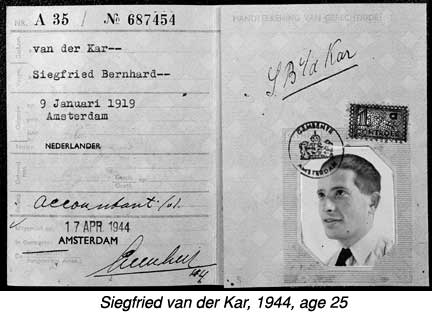
Early in the occupation of Holland, the Germans considered Siegfried Jewish because he had three Jewish grandparents. Then his mother, who was half-Jewish, was sent to The Hague to be examined by German doctors. They measured her skull, her feet; they gave her a complete examination. In the end they declared that she was 100 percent gentile. According to German policy, this turn of affairs made Siegfried one-half Jewish, a fact which he believes saved his life. It didn't help his sister, however, who was married to a Jewish man. They had to go into hiding. The Germans then emptied her family home of all its contents.
Rescuing Jewish people began for Siegfried when he and his wife hid a relative in their house, which put him in contact with others in a similar situation. Before long, he found he was part of a network of people, including Hendrik van Leston, finding hiding places, false identity papers, securing thousands of food coupons brought from Friesland in the north of Holland: all the dangerous but necessary activities to keep Jewish people safe from deportation. Despite being raided several times, they took in people who came to them in the middle of the night, desperate for a place to hide. Many of these people arrived in poor condition, dressed in dirty clothes, infested with lice and fleas. They slept on the floor of every room in his house, grateful for his lifesaving generosity.
At one point, Jewish neighbors next door gave them suitcases for safekeeping. Siegfried made the mistake of not checking their contents. In one of four police searches of their house the cases were discovered to contain clothing with yellow stars sewn on them. These were promptly confiscated along with all the (hidden) family's money secreted inside.
At the same time he was keeping people hidden in his house, Siegfried belonged to a group, working in a room of the Protestant church, that put together food packages they could send to Theresiendstadt and Bergen Belson concentration camps. At first the packages could only go to non-Jewish recipients, but at the war's end, Siegfried received letters of gratitude from former Jewish prisoners who had also benefitted from the duck eggs and toasted bread carefully packed into these boxes.
Go to the Next Page